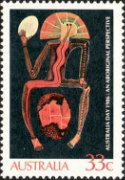History
Timeline results for 1970 to 1999
Found 232 results for your search. Showing page 7 of 12.
Year from 1970, year to 1999
1984
-
Enrolment and voting in Commonwealth elections is now compulsory for Aboriginal people.
-
The first stamp issue for the Australian Bicentennial shows Aboriginal rock art. It is interesting to note that the series is titled "First Australians" which only much later was agreed to be one of the appropriate terms for Aboriginal people. The first stamp introduces the bicentennial symbol. Australia Post also published a booklet with detailed explanations of the stamps called The First Australians: Our Heritage in Stamps (Australian Bicentennial Collection).
The designs show stick figures (Cobar Region, NSW), Bunjil's Cave (Grampians, WA), Quirkan Gallery (Cape York, QLD), a Wandjina spirit with snake babies (Gibb River, Kimberley, WA), a rock python (Gibb River), a silver barramundi (Kakadu National Park, Alligator Rivers Area, NT) and a rock possum (Kakadu National Park).


Although the captions use "First Australians" they fail to explain the locations of the rock art, a lost opportunity to raise awareness of this rich cultural heritage.
1985
-
In the ‘Come to Canberra Campaign’ joint land councils from the Northern Territory and the States go to Parliament House, Canberra to protest against the proposed changes to the Aboriginal Land Rights Act of the Northern Territory and the inadequate provisions in Labor Prime Minister Bob Hawke’s visions of ‘Uniform National Land Rights’.
-
The Pitjantjatjara council makes an agreement with Amoco Petroleum for exploration on 20 000 square kilometres of their land.
-
Commonwealth government returns Uluru Kata-Tjuta National Park (including Uluru/Ayer’s Rock) in the NT to its traditional Aboriginal owners.
There were dire warnings that The Rock belonged to everyone and fears that it would be taken away by Aboriginal people. As you can see, the rock is still here, people got their land rights and the sky hasn't fallen down.
— Gina Smith, Central Land Council, NT [1] -
Tasmanian Museum and Art Gallery, Hobart, Tasmania returns the Tasmanian Aboriginal human remains commonly known as the Crowther Collection (33 skulls and three skeletons) for cremation at Oyster Cove. The "largest gathering of Tasmanian Aboriginal people in a decade" attends the cremation [2].
1986
-
The ‘Goondiwindi riot’ between Aboriginal and non-Aboriginal residents of Goondiwindi, a country town of about 6,000 people on the New South Wales - Queensland border, leads to public acknowledgment of poor living standards and low socio-economic expectations of Aboriginal people in the area.
-

A Wandjina spirit protects the land. This stamp issue shows the continent of Australia cradled and protected by a Wandjina spirit. He holds a second egg in his hand, a symbol of perfection and rebirth. It also refers to the unbroken (and still misunderstood) Aboriginal spirit and how the land owns its people.
-
The Queensland government pays equal wages to Aboriginal workers on missions.
-
Pope John Paul II addresses Aboriginal and Torres Strait Islander people in Blatherskite Park in Alice Springs.
1987
-
Pat Dudgeon from the Bardi people (Kimberley area, Western Australia) graduates to become Australia’s first Aboriginal psychologist. She goes on to get her PhD in 2008.
-
Kevin Gilbert publishes Aboriginal Sovereignty, Justice the Law and Land where he explains First Nations' sovereignty position and to educate people on what sovereignty is and its inherent rights.
-
Stanley Tipiloura (Australian Labor Party), from Bathurst Island, is elected to the Northern Territory Legislative Assembly, representing the electorate of Arafura.
-
Aboriginal women, some as young as 13, are forcibly sterilised with the drug Depro Provera (made by Pfizer) despite serious side effects and being banned in the US. This is seen as one method by the government to control and reduce the number of Aboriginal people. [3] The UK, New Zealand and the US have similar practices. Permanent sterilisation through tubal ligation also occurred.
-
Northern Territory elections are held and for the first time voting is compulsory for Aboriginal people.
-
A Royal Commission into Aboriginal deaths in custody begins in response to high rate of Aboriginal incarceration and deaths.
-
Aboriginal Education Policy becomes mandatory for all schools.
-
Imparja Television Company, based in Alice Springs, Northern Territory, receives the first TV broadcasting license issued to an Aboriginal organisation.
-
‘Goondiwindi riot’ results in the first public inquiry for the new Human Rights and Equal Opportunity Commission (HREOC) - the Toomelah Inquiry which investigates the wider causes of racial conflict in the New South Wales and Queensland border towns of Toomelah, Boggabilla and Goondiwindi. Significant resources are allocated to meet basic housing, water, health and education needs.
-
In the lead up to the Bicentennial celebrations then Prime Minister Bob Hawke says that he would like to see the Bicentenary produce some sort of understanding or compact with Aboriginal people whereby the Australian community recognises its obligations to rectify some of the injustices of the previous 200 years.
References
View article sources (3)
[1]
'Anangu are still sharing culture', Koori Mail 488 p.13
[2]
''Tassie': A Roundup of Aboriginal Activities in Tasmania', Aboriginal Law Bulletin 60/1985, www.austlii.edu.au/au/journals/AboriginalLawB/1985/60.html
[3]
'Biomapping Indigenous Peoples: Towards an Understanding of the Issues', Susanne Berthier-Foglar, Sheila Collingwood-Whittick, Sandrine Tolazzi (eds), 2012 p.318


